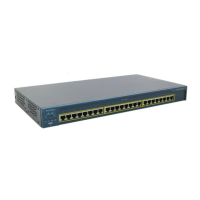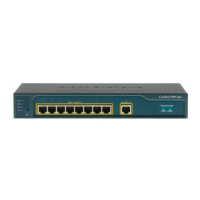1-5
Catalyst 2950 and Catalyst 2955 Switch Software Configuration Guide
78-11380-12
Chapter 1 Overview
Features
• Directed unicast requests to a TFTP server for obtaining software upgrades from a TFTP server
• Default configuration storage in flash memory to ensure that the switch can be connected to a
network and can forward traffic with minimal user intervention
• In-band management access through the embedded device manager through a Netscape Navigator
or Internet Explorer session or through Network Assistant
• In-band management access through up to 16 simultaneous Telnet connections for multiple
command-line interface (CLI)-based sessions over the network
• In-band management access through up to five simultaneous, encrypted Secure Shell (SSH)
connections for multiple CLI-based sessions over the network (only available in the enhanced
cryptographic software image)
• In-band management access through SNMP versions 1, 2c, and 3 get and set requests
• Out-of-band management access through the switch console port to a directly-attached terminal or
to a remote terminal through a serial connection and a modem
Note For additional descriptions of the management interfaces, see the “Management Options”
section on page 1-9.
Redundancy
• HSRP for command-switch redundancy
• UniDirectional Link Detection (UDLD) on all Ethernet ports for detecting and disabling
unidirectional links on fiber-optic interfaces caused by incorrect fiber-optic wiring or port faults
• IEEE 802.1D Spanning Tree Protocol (STP) for redundant backbone connections and loop-free
networks.
–
Up to 64 spanning-tree instances supported
–
Per-VLAN spanning-tree plus (PVST+) for load balancing across VLANs
–
Rapid PVST+ for load balancing across VLANs
–
UplinkFast, cross-stack UplinkFast, and BackboneFast for fast convergence after a
spanning-tree topology change and for achieving load balancing among redundant uplinks,
including Gigabit uplinks and cross-stack Gigabit uplinks
• IEEE 802.1s Multiple Spanning Tree Protocol (MSTP) for grouping VLANs into a spanning-tree
instance and for providing multiple forwarding paths for data traffic and load balancing and rapid
per-VLAN Spanning-Tree plus (rapid-PVST+), based on the IEEE 802.1w Rapid Spanning Tree
Protocol (RSTP) for rapid convergence of the spanning tree by immediately transitioning root and
designated ports to the forwarding state

